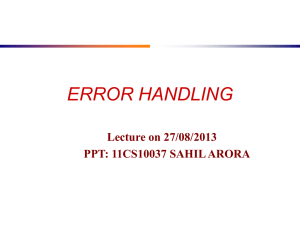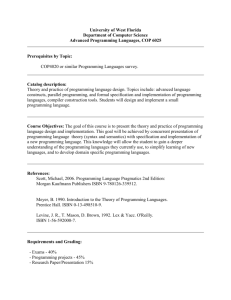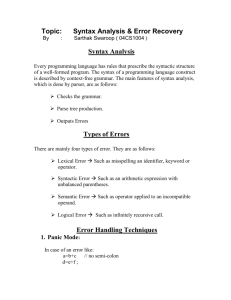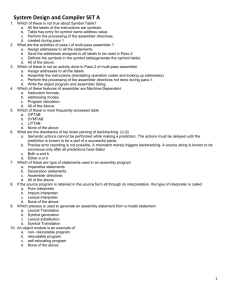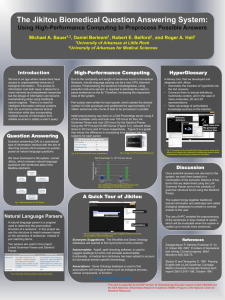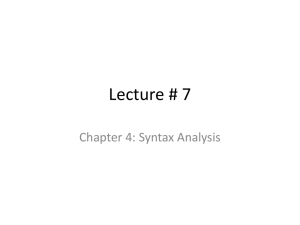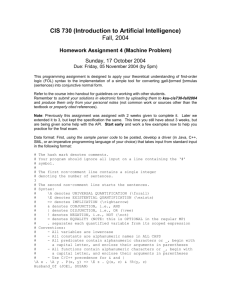PS1: Introduction and Parser Combinators
advertisement
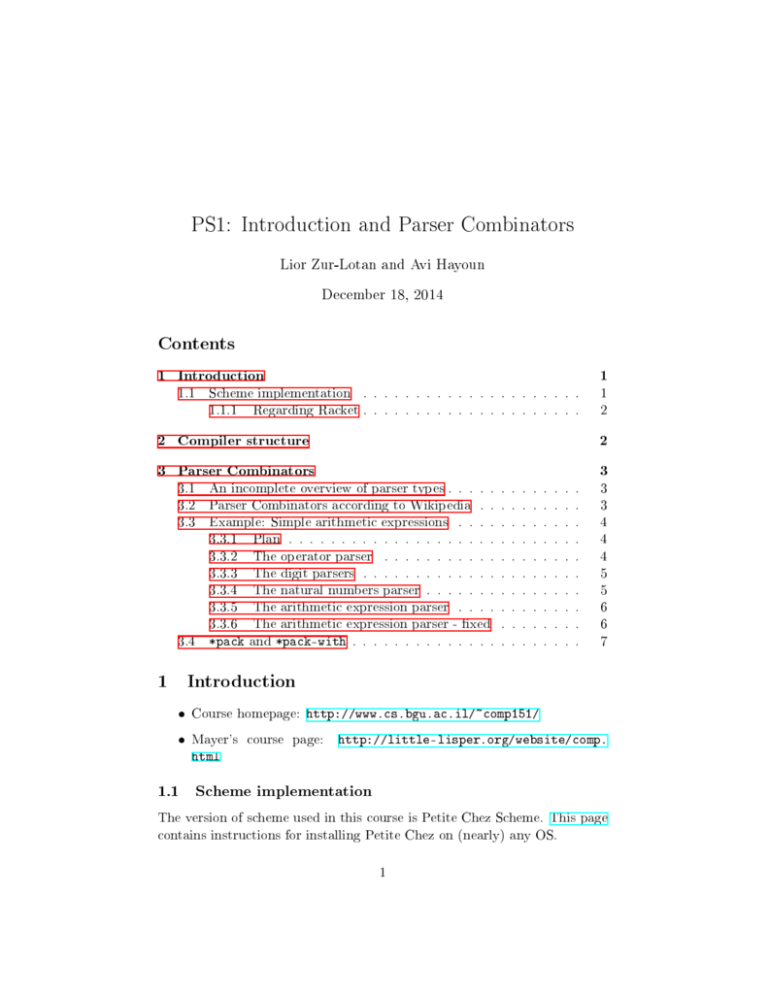
PS1: Introduction and Parser Combinators Lior Zur-Lotan and Avi Hayoun December 18, 2014 Contents 1 Introduction 1 2 Compiler structure 2 3 Parser Combinators 3 1.1 Scheme implementation . . . . . . . . . . . . . . . . . . . . . 1.1.1 Regarding Racket . . . . . . . . . . . . . . . . . . . . . 3.1 An incomplete overview of parser types . . . . . 3.2 Parser Combinators according to Wikipedia . . 3.3 Example: Simple arithmetic expressions . . . . 3.3.1 Plan . . . . . . . . . . . . . . . . . . . . 3.3.2 The operator parser . . . . . . . . . . . 3.3.3 The digit parsers . . . . . . . . . . . . . 3.3.4 The natural numbers parser . . . . . . . 3.3.5 The arithmetic expression parser . . . . 3.3.6 The arithmetic expression parser - xed 3.4 *pack and *pack-with . . . . . . . . . . . . . . . . . . . . . . . . . . . . . . . . . . . . . . . . . . . . . . . . . . . . . . . . . . . . . . . . . . . . . . . . . . . . . . . . . . . . . . . . . . . . . . 1 2 3 3 4 4 4 5 5 6 6 7 1 Introduction Course homepage: http://www.cs.bgu.ac.il/~comp151/ Mayer's course page: html 1.1 http://little-lisper.org/website/comp. Scheme implementation The version of scheme used in this course is Petite Chez Scheme. This page contains instructions for installing Petite Chez on (nearly) any OS. 1 1.1.1 Regarding Racket The version of scheme used in this course is Petite Chez Scheme. Not Racket. They are not the same. Although they are similar, Racket is not an implementation of the Scheme language. Feel free to work in Racket, but your assignments will only be tested using Chez. If your assignments do not work in Chez, you will get a 0 grade for your work, even if it runs perfectly in Racket. 2 Compiler structure A compiler is a computer program that transforms source code written in a programming language into another computer language. Structure of a compiler: Scanner (lexical analysis ) - converts a sequence of characters into a Parser (syntactic analysis ) - checks for correct syntax and builds a Semantic Analyzer - compiler adds semantic information to the Code Generator - process of converting some intermediate represen- sequence of tokens. hierarchical structure (parse tree) implicit in the input tokens. parse tree and builds the symbol table. This phase performs semantic checks such as type checking, object binding etc. tation of the source code into another computer language. 2 3 Parser Combinators The parser combinators library and a DIY tutorial for it are up on the course website under 'Useful Resources'. You are strongly encouraged to work through the tutorial, as it includes additional examples and more indepth explanations on some topics covered in this class. 3.1 An incomplete overview of parser types Top-Down parsers are parsers that try to build the parsing tree from LL parsers are a variation of Top-Down parsers. They consume the Recursive Descent Parsers are based on (perhaps mutually) re- a single starting non-terminal and expend it. Then they expand the new non-terminals created from the derivation and so on. input from left to right and they apply the derivation rules on the leftmost non-terminal in the current stage of the parse tree. We'll discuss LL parsers and their signicance in PS the next week or two. Just know for now that we are using a parser generator package that creates LL parsers (actually LL Recursive Descent parsers). cursive procedures where each procedure is usually responsible for a single derivation rule (sometimes it takes a few procedures to implement some rule and sometimes a few rules are implemented by one procedure). This creates a parser which is similar in structure to the CFG which denes the parser, and makes for very a easy-to-modify parser. The parser you will write in this course (as part of the compiler) will be written using parsing combinators. 3.2 Parser Combinators according to Wikipedia In functional programming, a parser combinator is a higher-order function which accepts several parsers as input and returns a new parser as its output. In this context, a parser is a function accepting strings as input and returning some structure as output. Parser combinators enable a recursive descent parsing strategy which facilitates modular piecewise construction and testing. This parsing technique is called combinatory parsing. Parsers built using combinators are straightforward to construct, readable, modular, well-structured and easily maintainable. 3 Remark. What this means in essence is that when creating a parser using parser combinators, we will construct only very basic, simple, production rules explicitly, and dene more complex production rules by iteratively composing simpler parsers. An example follows. 3.3 Example: Simple arithmetic expressions In this example, we will construct a parser for a simple grammar using parser combinators. The grammar will be of chained summation and subtraction of numbers, e.g. 100 − 5 + 72 − 32 − 1 + 0 + 7. Remark. As we will construct the parser using parser combinators, we will want to dene only the most basic production rules of the grammar explicitly. 3.3.1 Plan 1. Dene a parser for operations (+ or −). 2. Dene a parser for digits. 3. Dene a parser for numbers (we will stick to natural numbers for simplicity's sake). Do this using composition rules. 4. Dene a parser for an expression. 5. Expand a the expression parser into recursive parser for a chained expressions. 6. Output valid scheme code which will evaluate to the correct result. Remark. For simplicity's sake, the parser will assume right associativity of the arithmetical expression, so 1 + 2 − 3 will evaluate to 1 + (2 − 3). 3.3.2 The operator parser <op> → '+' | '-' 1 2 (define <op> (new ;initialize a parser stack 3 4 5 (*parser (char #\+)) ; create and push a parser for the '+' operator (*parser (char #\-)) ; create and push a parser for the '-' operator 4 6 7 (*disj 2) ; pop top 2 parsers, and push their disjunction 8 9 10 (*pack (lambda (op-char) ; transform the output (string->symbol (string op-char)))) 11 12 done)) ; fianlize the stack and return the top-most parser 3.3.3 The digit parsers <digit-0-9> → '1' | . . . | '9' 1 2 (define <digit-0-9> (range #\0 #\9)) <digit-1-9> → '1' | . . . | '9' 1 2 (define <digit-1-9> (range #\1 #\9)) 3.3.4 The natural numbers parser <nat> → <digit-1-9><digit-0-9>⋆ 1 2 3 4 (define <nat> (new (*parser (char #\0)) (*pack (lambda (_) 0)) 5 6 7 8 (*parser <digit-1-9>) (*parser <digit-0-9>) *star (*caten 2) 9 10 11 12 (*pack-with (lambda (x xs) (string->number (list->string `(,x ,xs))))) 5 13 14 15 (*disj 2) done)) 3.3.5 The arithmetic expression parser <expr> → <expr> <op> <nat> | <nat> 1 2 (define <exper> (new 3 4 5 6 (*delayed (lambda () <exper>)) ; allow recursion (*parser <op>) (*parser <nat>) 7 8 (*caten 3) 9 10 11 (*pack-with (lambda (n op expr) `(,op ,n ,expr))) 12 13 (*parser <nat>) 14 15 16 (*disj 2) done)) Left recursion: Immediate left recursion occurs in rules of the form A → Aα|β where α and β are sequences of nonterminals and terminals, and β doesnt start with A. The production <expr> → <expr> <op> <nat> is a left recursive production rule. In LL parsers (such as the one we are dening in the example above), such production rules cause an innite loop. We will discuss left recursion in more depth in a future class. For now, it is enough to realize that in the case of our grammar, the result is the same if we make the rule em right recursive instead: <expr> → <nat> <op> <expr>. 3.3.6 The arithmetic expression parser - xed <expr> → <nat> <op> <expr> | <nat> 6 1 2 (define <exper> (new 3 (*parser <nat>) (*parser <op>) (*delayed (lambda () <exper>)) 4 5 6 7 (*caten 3) 8 9 (*pack-with (lambda (n op expr) `(,op ,n ,expr))) 10 11 12 (*parser <nat>) 13 14 (*disj 2) done)) 15 16 3.4 *pack and *pack-with The *pack and *pack-with functions are also parser combinators, meaning they take a parser as input and composes it with some extra functionality. Unlike the other combinators (such as *caten and *disj), the packing combinators don't compose multiple parsers together, but rather allow us to transform the output of a parser before returning it. As an example, consider the code (*pack (lambda (_) 0)) from the <nat> parser. In this case, we are taking whatever is returned from the parser (char #\0) and returning the number 0 instead. *pack-with works similarly, but for *caten. So (*pack-with (lambda (n op expr) `(,op ,n ,expr))) takes the 3 expressions returned from <nat>, <op> and <expr>, and outputs a scheme expression which corresponds to the matched arithmetic expression: 1+2-3 → (+ 1 (- 2 3)). 7
